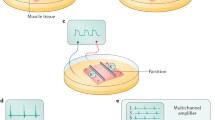Abstract
Myoelectric recordings from the gastrointestinal (GI) tract in conscious animals have been limited in duration and site. Recently, we have implanted 24 electrodes and obtained electrograms from these sites simultaneously (200 Hz sampling rate; 1.1 MB/min data stream). An automated electrogram analysis was developed to process this large amount of data. Myoelectrical recordings from the GI tract often consist of slow wave deflections followed by one or more action potentials (=spike deflections) in the same traces. To analyze these signals, a first module separates the signal into one containing only slow waves and a second one containing only spikes. The timings of these waveforms were then detected, in real time, for all 24 electrograms, in a separate slow wave detection module and a separate spike-detection module. Basic statistics such as timing and amplitudes and the number of spikes per slow wave were performed and displayed on-line. In summary, with this online analysis, it is possible to study for long periods of time and under various experimental conditions major components of gastrointestinal motility.







Similar content being viewed by others
References
Akin A, Sun HH (1999) Time–frequency methods for detecting spike activity of stomach. Med Biol Eng Comput 37:381–390
Alvarez WC, Mahoney LJ (1922) Action currents in stomach and intestine. Am J Physiol 58:476–493
Benson MJ, Castillo FD, Wingate DL, Demetrakopoulos J, Spyrou NM (1993) The computer as referee in the analysis of human small bowel motility. Am J Physiol 264:G645–G654
Bortoff A, Silin LF, Sterns A (1984) Chronic electrical activity of cat intestine. Am J Physiol 246:G335–G341
Bozler E (1942) The action potentials accompanying conducted responses in visceral smooth muscles. Am J Physiol 136:553–560
Bozler E (1946) The relation of the action potentials to mechanical activity in intestinal muscle. Am J Physiol 146:496
Crenner F, Lambert A, Angel F, Schang JC, Grenier JF (1982) Analogue automated analysis of small intestinal electromyogram. Med Biol Eng Comput 20:151–158
Dumpala SR, SN Reddy SK Sarna (1982) An algorithm for the detection of peaks in biological signals. Comput Programs Biomed 14:249–256
Ehrlein HJ, Hiesinger E (1982) Computer analysis of mechanical activity of gastroduodenal junction in unanaesthetized dogs. Q J Exp Physiol 67:17–29
Groh WJ, Takahashi II, Sarna S, Dodds WJ, Hogan WJ (1984) Computerized analysis of spike-burst activity of the upper gastrointestinal tract. Dig Dis Sci 29:422–426
Lammers WJEP, Stephen B, Arafat K, Manefield GW (1996) High resolution mapping in the gastrointestinal system: initial results. Neurogastroenterol Motil 8:207–216
Lammers WJEP, Ver Donck L, Schuurkes JAJ, Stephen B (2003) Longitudinal and circumferential spike patches in the canine small intestine in vivo. Am J Physiol 285:G1014–G1027
Lammers, Faes C, Stephen B, Bijnens L, Ver Donck L, Schuurkes JAJ (2004) Spatial determination of successive spike patches in the isolated cat duodenum. Neurogastroenterol Mot 16:775–783
Lammers WJEP, Ver Donck L, Schuurkes JAJ, Stephen B (2005) Peripheral pacemakers and patterns of slow wave propagation in the canine small intestine in vivo. Can J Physiol Pharmacol 83:1031–1043
Postaire J-G, Houtte NV, Devroede G (1979) A computer system for quantitative analysis of gastrointestinal signals. Comput Biol Med 9:295–303
Pousse A, Mendel C, Kachelhoffer J, Grenier JF (1979) Computer program for intestinal spike bursts recognition. Pflügers Arch 381:15–18
Pousse A, Mendel C, Vial JL, Greiner JP (1978) Computer program for intestinal basic electrical rhythm pattern analysis. Pflügers Arch 376:259–262
Roelofs JMM, Akkermans LMA, Schuurkes JAJ (1987) Computer aided analysis of electrical and mechanical activity of stomach and duodenum. Z. Gastroenterologie 25:107–111
Schemann M, Ehrlein HJ (1985) Computerised method for pattern recognition of intestinal motility: functional significance of the spread of contractions. Med Biol Eng Comput 23:143–149
Schuurkes JAJ, Akkermans LMA, Van Nueten JM (1986) Computer analysis of antroduodenal coordination: comparison between cisapride and metoclopramide. Gastroenterology 90:1622
Summers RW, Cramer J, Flatt AJ (1982) Computerized analysis of spike burst activity in the small intestine. IEEE Trans Biomed Eng BME-29:309–314
Ver Donck L, Lammers WJEP, Moreaux B, Voeten J, Veckemans J, Schuurkes JAJ, Coulie B (2006) Mapping slow waves and spikes in chronically instrumented conscious dogs: implantation techniques and recordings. Med Biol Eng Comput 44:170–178
Wang Z, Chen JD (2001) Blind separation of slow waves and spikes from gastrointestinal myoelectrical recordings. IEEE Trans Inf Technol Biomed 5:133–137
Weisbrodt NW, Christensen J (1972) Electrical activity in the cat duodenum in fasting and vomiting. Gastroenterology 63:1004–1010
Wingate DL, Ruppin H, Green WER, Thompson HH, Domschke W, Wunsch E, Demling L, Ritchie HD (1976) Motilin-induced electrical activity in the canine gastrointestinal tract. Scand J Gastroenterol 11(Suppl 39):111–118
Acknowledgments
The authors wish to acknowledge the expert animal care provided by the staff of the Department of Laboratory Animal Science, in particular Mr. Jef Ceulemans for training the dogs and Mr. Piet Dierckx, DVM, and Mrs. Leen Roefs for daily animal care.
Author information
Authors and Affiliations
Corresponding author
Rights and permissions
About this article
Cite this article
Lammers, W.J.E.P., Michiels, B., Voeten, J. et al. Mapping slow waves and spikes in chronically instrumented conscious dogs: automated on-line electrogram analysis. Med Bio Eng Comput 46, 121–129 (2008). https://doi.org/10.1007/s11517-007-0294-7
Received:
Accepted:
Published:
Issue Date:
DOI: https://doi.org/10.1007/s11517-007-0294-7




